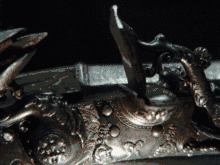Snaplock
A snaplock is a type of lock for firing a gun or is a gun fired by such a lock.

A snaplock ignites the (usually muzzleloading) weapon's propellant by means of sparks produced when a spring-powered cock strikes a flint down on to a piece of hardened steel. The snaplock is therefore similar to the snaphaunce (sometimes classed as an advanced type of snaplock) and the later flintlock (see below).
In all snaplocks, the flint is held in a clamp at the end of a bent lever called the cock. When the gun is "cocked", the cock is held back, against the pressure of a spring, by a catch which is part of the trigger mechanism. When the trigger is pulled, the catch is released and the spring moves the cock rapidly forwards. The flint strikes a curved plate of hardened steel, called the "steel". The flint strikes from the steel a shower of white hot steel shavings (sparks) which fall towards the priming powder held in the flash pan. The flash from the pan's ignited primer travels (unless there is only a "flash in the pan") through the touch hole into the firing chamber at the rear of the barrel, and ignites the main charge of gunpowder.[1]
Before the weapon is fired, the pan has a closed cover: the mechanism for opening this cover (i.e. manual or automatic) can affect whether the weapon is classed as a snaplock. In fact, the term snaplock may be used in three ways, as follows:
- The most general use of snaplock is for any lock which strikes flint against steel but which does not have the defining feature of a true flintlock. This is the frizzen, a single piece of metal which is a combined "steel" and self-opening pan cover.
- A more restrictive definition excludes the snaphaunce, more sophisticated weapons with a lateral sear and a pan cover, separate from the steel, that opens automatically.
- Sometimes the term is used only for specific Scandinavian, German, and Russian varieties of lock.
Period of use
The snaplock first appeared in the late 1540s, probably in southern Germany.[2] It was cheap and easy to produce, and like all post-matchlock weapons, could be primed and loaded in advance and be fired at a moment's notice. It fell out of favor by about 1640, except in Sweden and Russia, where it lasted far longer.[3]
Safety
Snaplocks as a class did not have safety devices, but individual models could be prevented from inadvertent firing by different mechanisms:
- In the early models with a manual pan cover, the steel could be swung out of the path of the flint until just before firing; also, a closed pan cover would not allow the primer to ignite and could help keep the primer dry in misty conditions.
- On some models, an external hook attached to the lock plate could engage the tip of the "cocked" cock to prevent it from moving forwards.
Regional varieties include the Baltic Lock, the Russian Snaplock, and the Miquelet lock. The Swedish king Gustavus Adolphus had many matchlock muskets converted to snaplocks during his military reforms.
See also
- Caplock mechanism
- Firearm
- Flintlock
- Hand cannon
- Matchlock
- Miquelet
- Percussion cap
- Snaphance
- Wheellock
- Doglock
References
- Heard, Brian J (2013). "Forensic Ballistics in Court". download.e-bookshelf.de. Wiley-Blackwell. pp. True Flintlock (Figure 1.0.4). ISBN 978-1-119-96268-7. Retrieved 2017-12-13.
- Blair 1983:42
- Blair 1983:67
- Blair, Claude. Editor. Pollard's History of Firearms. New York: Macmillan, 1983
- Chase, K. (2003), Firearms: A Global History to 1700, Cambridge University Press, ISBN 0-521-82274-2
- Fowler, W., North, A. & Stronge, C. The Development of Small Firearms, from 12th-century Hand Cannons to Modern-day Automatics.